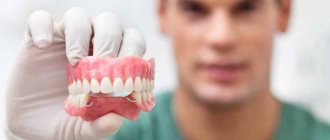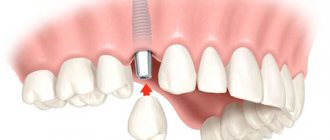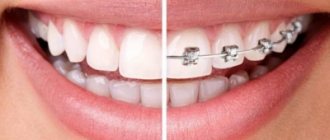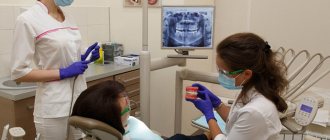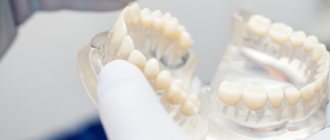Author: ProfGid
A prosthetic dentist or orthopedic dentist is a specialist who is approached for artificial reconstruction of teeth when there is no way to cure and preserve them. Thanks to modern technologies, such a doctor can restore oral health and a beautiful smile to any patient. The profession belongs to the category “ person – person ”. By the way, in 2022, the ProfGid career guidance center developed an accurate career guidance test. He himself will tell you which professions are suitable for you, and give an opinion about your personality type and intelligence.
Short description
An orthopedic dentist first receives a general dental education and then studies his future specialization in depth. He is responsible for all stages of selection, preparation and installation of dentures in their modern variations. This is one of the most sought-after dental profiles on the labor market, as it allows both to restore full functionality of the jaw and to give the patient a beautiful smile.
Dentists: what are they?
Dentistry is a fairly broad area of medicine, which is divided into several specific areas: therapy, surgery, orthopedics, orthodontics, periodontics and others. Depending on the chosen qualifications, skills and abilities, each doctor has his own area of responsibility and set of actions performed.
To understand which dentist to contact in various situations and what is the difference between an orthopedist and an orthodontist, a surgeon and a therapist, you should know the features of their activities.
Specialists often work together and closely interact with each other, because the patient may need a set of measures aimed at completely restoring the problem area of the oral cavity.
Dentist-therapist
It all usually starts with this dentist.
People come to him when they are worried about toothache or other symptoms associated with the maxillofacial area. He conducts diagnostics and an initial examination, establishes a diagnosis and prescribes treatment, and gives referrals to specialized specialists. His competence includes standard problems: caries, infectious diseases and inflammatory processes in the oral cavity. Dentist-therapist:
- cleans channels;
- removes nerves;
- installs seals;
- removes tartar and plaque;
- restores teeth;
- performs sanitation of the oral cavity before prosthetics or other dental procedures.
Dental surgeon
This doctor comes to the rescue if conventional treatments are ineffective and drastic solutions are needed that require surgical intervention.
Dental surgeon:
- removes teeth, tumors and cysts;
- eliminates acquired and congenital defects;
- opens foci of abscess and other inflammations;
- prepares the jaw for prosthetics and performs implantation;
- deals with restoration and plastic surgery of the jaw, as well as any other operations in the oral cavity.
Dentist-orthodontist
This doctor deals with dental disorders associated with malocclusion, which he corrects with the help of braces, mouthguards, plates and other devices. These can be genetic, congenital, age-related, acquired as a result of a disease or deformation anomaly:
- individual teeth;
- dental arches;
- jaws.
There are several other important specialties among dentists:
- Periodontist. Treats periodontal diseases, which is a complex of tissues surrounding the teeth and ensuring their fixation.
- Children's dentist. It differs from an adult dentist, since milk teeth, developing jaws and the child’s psyche have their own characteristics. This requires certain knowledge for proper treatment.
- Dental Technician. Engaged in the manufacture of dentures in dental laboratories.
But the main direction that makes it possible to restore teeth even in cases where other dentists are unable to help is dental orthopedics.
Features of the profession
Not every person manages to keep their teeth healthy throughout their life. However, many technologies and materials for dental prosthetics can effectively solve this problem. And if decades ago dentures did not look very beautiful and did not always take root, modern technologies significantly reduce the risk of implant rejection and make it possible to give the dentition an aesthetic, natural look. A prosthetic dentist is fluent in all methods of restoring lost teeth, and his main job responsibilities are as follows:
- examination of the patient, collection of anamnestic data, selection of prosthetic methods suitable for a specific individual case, counseling the patient;
- taking dental impressions;
- production of prostheses from modern materials using high-tech equipment;
- installation of pins in the patient’s jaw, fitting of dentures;
- temporary installation of dentures, correction of detected imperfections;
- securing prostheses for permanent wear.
Dentures can be removable, fixed, conditionally removable, these can be implants, bridges, inlays, crowns. Some technologies gradually cease to be used, and they are replaced by new, more advanced ones. But, in any case, only a professional prosthetist dentist can choose the optimal option for any patient with impaired chewing function or complaints of cosmetic defects in the dentition.
Orthopedics as a field of dentistry
In general, orthopedics is a large branch of the medical system that deals with disorders of the musculoskeletal system, and orthopedics in dentistry is only an independent part of it.
Dental orthopedics specializes in eliminating problems with the masticatory-speech apparatus , based on restoring its function and integrity through the installation of dentures. This procedure is called prosthetics.
You should contact dental orthopedics if:
missing teeth - from one to completely edentulous;- tooth decay is observed - both complete and partial;
- increased mobility or sensitivity of the teeth, and there are also other problems with the tissues and bones of the jaw - periodontal disease, periodontitis, etc.;
- there are cosmetic defects - the shape, size, color do not match or other aesthetic defects are noticeable;
- pathology of the temporomandibular joint has been established;
- This visit to the orthopedist was recommended by another dentist who, during examination or treatment, considered such a visit necessary.
Appointments in orthopedic offices are conducted by specialized highly specialized doctors of a high category - orthopedic dentists.
Advantages and disadvantages
pros
- A prestigious, in-demand profession.
- High salary level.
- Possibility of retraining in related areas of psychology.
- The opportunity to see the real result of your work.
Minuses
- The need to work with the dental cavities of different patients and, as a result, the need for the absence of disgust.
- The need to constantly monitor the development of new technologies and news from the world of dentistry.
- Quite a high level of requirements for specialists.
Who is this?
An orthopedic dentist deals with the creation of dental implants for the treatment of many diseases of the oral area.
At the same time, orthopedic science itself is a separate direction in medicine; it is in no way connected with dentistry as a whole. The specialty in question appeared relatively recently; such specialists are engaged in solving problems in the diagnosis, research and treatment of various oral pathologies, and also design and manufacture inserts for tooth enamel.
High-quality treatment is provided for the entire range of pathologies and abnormalities that are directly related to speech function and the chewing and speech apparatus.
Important personal qualities
A prosthetist dentist is required to be responsible, attentive, collected, focused, and patient. In terms of the level of attention to detail required, his work is close to that of jewelry; making mistakes and carelessness in it is unacceptable (especially considering the high cost of consumables). In addition, like any doctor, such a dentist must have certain empathy abilities, a desire to help people, and the ability to find a common language with them. He should also be characterized by a desire for constant development and self-improvement.
Specializations and methods of prosthetics
During orthopedic treatment, various techniques are used, each of which has its own specific indications.
Microprosthetics
Microprosthetics is a method used by dentists in situations where a tooth, although preserved to a greater extent, cannot function normally or has an unpresentable appearance.
To correct such problems, orthopedists use inlays and veneers. An inlay is almost the same as a filling, only more elaborate. Using inlays, only part of the tooth is recreated. Most of all, they are used when restoring parts of chewing teeth, for which, in addition to appearance, functionality is extremely important.
The inlays are made from a very durable material - ceramics. In addition to strength, this material also has a number of advantages. First of all, it has an excellent appearance, similar to tooth enamel. In addition, ceramics are absolutely safe for the human body, as they are of natural origin.
In addition to ceramic inlays, veneers are also made. Prosthodontists use them on the front teeth to create a beautiful smile. Veneers are not used to restore chewing molars, since the product is quite fragile and is intended for the front side of the teeth.
Veneers are fairly thin plates, about half a millimeter thick. Their shape follows the outer part of the tooth, at the base of which there is a depression. Using special cement without color, odor or side effects, orthopedic doctors attach veneers to the teeth. Cement is very durable and can last for about ten years.
Veneers can eliminate many defects in tooth enamel. These are scratches, chips, cracks, natural yellowness of the teeth, as well as their slight curvature.
Before installing veneers, dentists grind down the enamel of the teeth so that after installation it does not take a long time to get used to them, and they do not interfere with the patient’s smiling, talking and eating. This stage of installation is the most unpleasant for the patient. When removing enamel, the dentist needs to be as careful and careful as possible. The enamel is removed with a drill, and anesthesia is applied.
The result of installing veneers is a perfect smile in a couple of days. If worn carefully, they will last a very long time without changing their appearance.
A patient who has veneers installed will need to wear them constantly, changing them every 10 years, since worn-down enamel is not restored. With each veneer replacement, the orthopedic dentist will have to grind down the enamel again and again. After such procedures, the tooth will become thinner and thinner, and eventually it will need to be replaced with a crown - a permanent prosthetic product.
Tabs
They resemble fillings, but with the difference that they are made of ceramic , and therefore have great strength and excellent appearance.
Inlays are made from impressions and are mainly used for prosthetics of chewing units.
Veneers
These are thin (0.5 mm) plates glued to the front surface of the tooth in order to hide its defects (chips, scratches, yellowness).
In their shape, veneers exactly repeat the outer part of the tooth, to which they are glued using a special cement that is biocompatible with dentin, colorless and odorless.
The adhesive ensures a long – up to 10 years – service life of the veneer. With each replacement, the enamel becomes thinner due to grinding.
The advantages of veneers include the relative ease of installation and the excellent appearance they give to the oral cavity.
The disadvantages are the need for periodic replacement and the inability to withstand significant chewing loads. Therefore, they are installed only on the front units.
Lumineers
In terms of function and appearance, these are almost the same as veneers, with the only exception - they are much thinner than veneers, which allows them to be installed without grinding down the enamel.
Advantages of microprosthetics:
- These are gentle operations that do not injure healthy neighboring teeth;
- Not only aesthetics are restored , but also functionality;
- Impeccable quality. Thanks to the ability to make from impressions, very high quality microprostheses are ensured.
- The ability to use the most modern materials , similar in characteristics to natural enamel.
In many cases, microprosthetics is an ideal, without a worthy alternative, method of high-quality and quick restoration of the appearance and functionality of teeth.
Permanent prosthetics
This type of prosthetics includes bridges and crowns, which are larger and more durable products than veneers and inlays.
A crown is a kind of cap that is placed on a tooth and replaces its visible part.
The purposes of using crowns are different. With their help, orthopedists can restore damaged or even missing teeth, as well as attach a bridge or removable prosthesis to them.
The crown is made in a dental laboratory and then attached to an implant or treated tooth.
The need for crowns arises in cases of severe tooth decay due to physical damage or diseases of the oral cavity (primarily caries). In these cases, microprosthetics will not help.
Crown installation steps:
- Tooth preparation. Grinding it and the required small workpiece (stump). The dentist removes the required amount of enamel and dentin (2 - 3 millimeters) from all sides of the tooth. In the case of installing a prosthesis on a titanium implant inserted into the jaw, the procedure does not occur until the tissue has completely healed.
- Formation of an impression from which the prosthesis will be made.
- Test wearing. The crown is installed using temporary cement. The patient uses it for some time and observes the condition.
- Final installation. If there is no discomfort when wearing a temporary crown, you can install it using stronger cement.
Crowns, depending on the characteristics of the patient and the recommendations of the orthopedic surgeon, can be made of plastic, metal or ceramics.
Ceramic crowns are durable and have an excellent appearance. But the material is quite expensive due to its many positive qualities.
This is interesting: Metal-ceramics or ceramics: what is the difference, what is better to choose for installing crowns
Metal-ceramic crowns have a titanium frame and are coated with ceramic on the outside. For this reason, their prices are more affordable. But the appearance is inferior to ceramic ones, since metal can be seen through thin ceramics.
Plastic crowns are worn for no more than a year, so they can be classified as temporary. Often, orthopedic dentists install them temporarily while the permanent ones are being made.
Using a crown if you lose one tooth is an excellent option, but if several teeth are missing at once, this method loses. After all, you will need to install implants, pay for their cost and the cost of each crown.
As dentists say, in this case it is better to use bridges. These are the same crowns that are combined into one system and replace several teeth at once.
The duration and cost of installing bridges is quite less, so their installation in the absence of several teeth is much more profitable. Bridges are usually attached to inlays or telescopic crowns.
Crowns
These are orthopedic structures in the form of a cap covering all or part of the crown.
They are used if the defect cannot be corrected by filling or installing an inlay, as well as to change the color, position or shape of teeth, to attach bridges or splinting.
Depending on the degree of coverage of the tooth, crowns can be full or partial. By material - metal, non-metal (plastic, ceramic) and combined (a combination of metal with plastic or ceramics).
According to the manufacturing method, there are cast, stamped, soldered, milled, polymerized, and also produced by firing (ceramic and porcelain).
Bridges
Such structures are used if several adjacent units have been destroyed.
Along the edges of the bridge are crowns that are placed on the supporting units.
The structure located between them - a “bridge” - replaces one or more missing teeth.
Implants
Dental implants are an artificial structure that is inserted into the bone tissue of the jaw and then fuses with it.
They look like screws or thick screws. Implants take over the function of the roots of the lost units, and are used as a base for restoring rows.
Removable prosthetics
Today, removable dentures are used not only by older people.
They are often necessary even for children. After the loss of a baby tooth, dentists provide children with a removable denture to prevent curvature of the dentition until a new one grows. Removable dentures can be removed and put on at the right time. Which makes caring for them and the installation process itself quite simple.
Note: For older people, installing removable dentures is most acceptable, because installing implants in old age is risky, and if a tooth is lost, you can either resort to implantation or use a removable denture.
A removable denture includes a plastic or nylon base and artificial teeth.
The prosthesis can be complete (for the entire jaw) or partial, which is essentially a bridge, only it can be removed.
Orthopedists attach a removable denture using special locks or compounds.
The most common clasps are clasps in the shape of a semicircle, clasping the abutment teeth on both sides. Clasps are used to secure partial dentures, while full dentures are held in place with glue or suction. Dentures are most tightly secured using locking implants.
Conditionally removable technique
The conditionally removable technique involves the use of clasp prosthetics or installation of structures on implants. The orthopedic device is considered conditionally removable, as it is fixed using special latches.
The structure can only be removed by applying a certain force. In some cases, the help of an orthopedist may be needed. This type of technique is indicated both in the absence of all teeth and a small group of them.
Training to become a prosthetist dentist
In order to have the opportunity to immerse yourself in this profession, you must obtain a higher medical education in the general profile of “Dentistry” ( specialty code - 05/31/03 ). To do this, you need to take the Unified State Exam in the Russian language, chemistry and biology or physics (each university sets the exact list of disciplines individually).
Training is most often carried out in a full-time format; some universities offer part-time and part-time education. It lasts 5-6 years, after which you will need to complete a residency in your specialization to gain deeper practical skills, knowledge and abilities.
Duration of training
The duration of training and the form are closely interrelated. You can study at:
- full-time;
- individual form.
There is no correspondence form for this specialty. For full-time study, the duration will be 2 years, and for individual study, it is set at the discretion of the educational institution. However, it can increase to no more than three years.
Career
in the same position throughout his work history , but, as his skills improve (and move to different clinics), his income increases. Or he can become the head of the department, then, after some time, receive the position of deputy chief physician of the clinic, and then become the chief physician . A faster option for this career advancement has already been mentioned - this is opening your own medical institution, but it will require financial investments and the solution of many organizational issues. With a focus on research and development, an orthopedic dentist can become a candidate, and then a doctor of science .
Types of prosthetics
The choice of type of prosthetics depends on many factors. Here the role is played by the condition, number and location of the teeth, the individual characteristics of the patient, pricing policy and other circumstances. The difference in what the orthopedic dentist does in each individual case lies in the techniques used and the prostheses used.
Microprosthetics
Suitable for situations where you need to restore a deformed or damaged tooth. The following prostheses are used:
- Veneers. The doctor places them if there are minor defects in the front teeth: chips, cracks, curvature, discoloration. Veneers are thin ceramic plates up to 0.7 mm wide that completely follow the shape of the tooth, are installed in one appointment and last up to 10 years.
- Lumineers. They are placed when, for some reason, veneers are contraindicated for the patient. These pads are slightly different from each other. The difference is that lumineers are thinner (0.3 mm), more difficult to get used to, hide defects less, and are more prone to breakage.
- Tabs. They are very similar to fillings, but they also have some differences: they last longer, are made of durable ceramics, are able to recreate the shape of the tooth, and are also used when the filling is ineffective.
Removable dentures
Removable dentures are inexpensive, easy to install, and easy to care for. These dentures come in several types: plate, clasp, suction cups, butterflies. Removable structures are most often used:
- with edentia - if there are missing teeth on one or both jaws;
- for elderly people - other types of prostheses are more expensive and may not be well tolerated by the elderly;
- for children - when early loss of baby teeth can cause crooked dentition.
Fixed structures
Fixed dentures are durable and reliable, have an attractive appearance, and are made from different materials, which makes it possible to provide prosthetics to people with any financial capabilities. These include:
- crowns are prostheses that are placed in a wide variety of situations, but most of all they are suitable for frontal single molars;
- Bridges are an excellent solution when several teeth are missing in a row;
- dentures on implants - this design will last a lifetime, but it also costs accordingly.
Based on the results of this article, we can conclude that an orthopedic dentist treats all types of tooth loss, up to their complete absence. Today, insufficient dentition is not a problem, because to solve it you just need to go to one of the many clinics where qualified prosthetists work.
How are you connected with other doctors?
The work of a specialist in the specialty in question is in direct connection with the activities of the therapist.
Only after a complete examination of the oral cavity can a high-quality denture be manufactured and installed.
Also, for this, an orthopedist can use the services of a surgeon who first removes rotten and lost teeth from the oral cavity.
Participation in the process of prosthetics on the part of the surgeon may be necessary at absolutely any stage of such an operation, including preparation for the installation of implants.
If local anesthesia methods are used during the procedure in question, a resuscitator or anesthesiologist is involved. If a malocclusion is previously formed, an orthodontist is involved.
In some cases, an orthopedist is able to do without the involvement of third-party specialists.
But this is only possible when the patient’s oral cavity and gums are in perfect health. Otherwise, the involvement of specialists from related medical fields is inevitable.
Diagnostic measures
An orthopedic dentist uses the following diagnostic methods.
- Interviewing the patient and collecting anamnesis.
- Examination of the face. The size of the mouth gap, shortening of the lower area of the face, its asymmetry (if any), position of the chin and lips are recorded. Palpation is used to check the tone of the labial muscles.
- Inspection of PR. The shape, size and number of teeth, and bite are studied in detail. The condition of the mucous membrane, the peculiarities of the formation of the frenulum of the lips, the range of movements and the shape of the tongue, the morphology of the vault of the hard palate, and the development of the jaws are assessed. Attention is focused on the functionality of the TMJ when working the lower jaw.
Using radiography, the condition of the supporting units, the presence of impacted and rudiments of permanent elements is determined.
As additional methods, special studies of the functions of the jaw apparatus may be prescribed:
- Functional chewing tests.
- Condition of nasal breathing (rhinoscopy, rhinopneumometry, rhinomanometry).
- Dimensions, shapes, position and functionality of the tongue (teleradiography).
- The relationship of the parts of the skull relative to each other (cephalometry).
Based on the examination results, a diagnosis is made and orthopedic treatment tactics are developed.
Examination methods and technologies used
One of the conditions for the successful work of an orthopedist is a correct diagnosis. To obtain a detailed picture of the disease and identify even minor deviations in the development of the jaw and teeth, they most often resort to an orthopantomogram, wax modeling and computed tomography.
Orthopantomogram
It is an x-ray examination method that makes it possible to obtain images of both jaws at once in different projections. It is used to study the position of individual teeth, the condition of their roots and tissues.
In addition, an orthopantomogram is used to determine the relationship of the dentition of the upper and lower jaws in relation to each other. The study is prescribed both before the start of treatment and during it.
Wax modeling
One of the mandatory orthopedic diagnostic techniques is wax modeling. It is intended to determine the position of the teeth and further manufacture of the prosthesis. The more detailed the modeling is, the better the quality of the prosthesis produced.
CT scan
This type of study allows you to study the condition and structure of the bone of the alveolar ridge, teeth and periodontium. Thanks to the layer-by-layer method of tissue examination, the most minor deviations are identified, which can negatively affect the placement of orthopedic structures.
Most often, computed tomography is used before the implantation procedure and during its operation.


